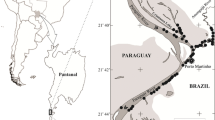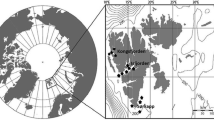Abstract
Seasonal changes in morphology and size in a Daphnia hyalina population were studied during one year. In addition to the total length, carapace and head lengths were also measured. At the beginning of the year, the large Daphnia produce large neonates. With the coming of the warm season, a decrease in size at first reproduction and minimum size of neonates is observed which may be related to the increase in food availability. Also the maximum size attained tends to decrease from spring to summer, probably in relation to the increase in fish predation. A general increase in size is again found in late summer (August) as a result of the increase in head length and in head/carapace ratio, mainly observed in the smaller size fraction of the population (≤ 1000 µm). This result supports the hypothesis of invertebrate predation as a major factor responsible for the success of ‘long head morphs’.
Similar content being viewed by others
References
Banta, A. M., 1939. Studies on the physiology, genetics and evolution of some Cladocera. Carnegie Institution of Washington, Washington D.C.: 277 pp.
Berg, K., 1931. Studies on the genus Daphnia O. F. Müller with special reference to the mode of reproduction. Vidensk. Medd. Dan. Nat. Foren. 92: 1–222.
Berg, K. & E. Grimaldi, 1966. Ecological relationship between planktophagic fish species in the Lago Maggiore. Verh. int. Ver. Limnol. 16: 1065–1073.
Brambilla, D. J., 1980. Seasonal changes in size at maturity in small pond Daphnia. 438–455.
Brooks, J. L., 1965. Predation and relative size in cyclomorphotic Daphnia. Proc. natn. Acad. Sci. USA. 52: 119–126.
Brooks, J. L., 1965. Predation and relative helmet size in cyclomorphic Daphnia. Proc. natn. Acad. Sci. USA. 53: 119–126.
Clarke, G. L. & D. J. Zinn, 1937. Seasonal production of zooplancton off Woods Hole with special reference to Calanus finmarchicus. Biol. Bull. 73: 464–487.
Coker, R. E. & H. H. Addlestone, 1938. Influence of temperature on cyclomorphosis of Daphnia. J. Elisha Mitchell Sci. Soc. 54: 45–75.
Culver, D. A., 1980. Seasonal variation in size at birth and at first reproduction in Cladocera. In: W. C. Kerfoot (ed.), Evolution and Ecology of Zooplankton Communities. The University Press of New England, Hanover (N.H.). Lond.: 358–366.
Culver, D. A. & W. R. De Mott, 1978. Production of zooplankton at nearshore stations in Lakes Ontario and Erie. Int. Ver. Theor. Angew. Limnol. Verh. 20: 252–256.
Daborn, G. R., J. A. Hayward & T. E. Quinney, 1978. Studies on Daphnia pulex Leydig in sewage oxidation ponds. Can. J. Zool. 56: 1392–1401.
de Bernardi, R., 1974. The dynamics of a population of Daphnia hyalina Leydig in Lago Maggiore, Northern Italy. Mem. Ist. ital. Idrobiol. 31: 221–244.
de Bernardi, R., 1981. Biotic interactions in freshwater and consequences for community structure. Boll. zool. ital. 48: 351–371.
de Bernardi, R. & G. Giussani, 1975. Population dynamics of three cladocerans of Lago Maggiore related to predation pressure by a planktophagous fish. Verh. int. Ver. Limnol. 19: 2906–2912.
de Bernardi, R. & M. Manca, 1980. Accumulo di energia e tempo di inerzia nella riposta di popolazioni di Daphnia alle fluttuazioni ambientali. In: A. Moroni, O. Ravera & A. Anelli. Atti del Primo Congresso della Società Italiana di Ecologia. Salsomaggiore Terme: 21–24 October 1980: 189–194.
de Bernardi, R. & M. Manca, 1982. The consequences of life history strategies on competition between two cladocerans. Mem. Ist. ital. Idrobiol. 40: 145–161.
de Bernardi, R., G. Giussani, D. Ruggiu & M. Manca, 1980. Long-term dynamics of plankton communities in Lago Maggiore (N. Italy). Verh. int. Ver. Limnol. 23: 729–733.
Gilbert, J. J., 1967. Asplanchna and posterolateral spine production in Brachionus calyciflorus. Arch. Hydrobiol. 64: 1–62.
Gilbert, J. J., 1977. Defenses of males against cannibalism in the rotifer Asplanchna: Size, shape and failure to elicit tactile feeding responses. Ecology 6: 1128–1135.
Green, J., 1956. Growth, size and reproduction in Daphnia (Crustucea: Cladocera). Proc. zool. Soc. Lond. 126: 173–204.
Green, J., 1966. Seasonal variation in egg production of Cladocera. J. anim. Ecol.35: 77–104.
Haempel, O., 1925. Daphnia cucullata des Attersees, eine typische Winterform mit Cyclomorphose. Zool. Anz.65: 65–68.
Hall, D. J., 1964. An experimental approach to the dynamics of a natural population of Daphnia galeata mendotae. Ecology 45: 94–112.
Hutchinson, G. E., 1967. A treatise on limnology, 3. John Wiley & Sons, New York, 660 pp.
Hrbácek, J., 1959. Circulation of water as a major factor influencing the development of helmets in Daphnia cucullata Sars. Hydrobiologia 13: 170–185.
Hrbácková-Esslová, M., 1963. The development of three species of Daphnia in the surface water of the Slapy Reservoir. Int. Revue ges. Hydrobiol. 48: 325–333.
Hrbácková, M. & J. Hrbácek, 1978. The growth rate of Daphnia pulex and Daphnia pulicaria (Crustacea, Cladocera) at different food levels. Vest. Cesk. Spol. Zool. XLII(2): 115–127.
Jacobs, J., 1961. On the regulation mechanism of environmentally controlled allometry (heterauxesis) in cyclomorphotic Daphnia Pysiol. Zool. 34: 202–216.
Jacobs, J., 1967. Untersuchungen zur Function und Evolution der Zyclomorphose bei Daphnia, mit besonder Berücksichtigung der Selektion durch Fische. Arch. Hydrobiol. 62: 467–541.
Jacobs, J., 1967. Coexistence of similar zooplankton species by differential adaptation to reproduction and escape, in an environment with fluctuating food and enemy densities. I. A model. Oecologia 29: 233–247.
Jacobs, J., 1980. Environmental control of cladoceran cyclomorphosis via target-specific growth factors in the animal. In: W. C. Kerfoot (ed.), Evolution and Ecology of Zooplankton Communities. The University Press of New England, Hanover (N.H.); Lond.: 429–437.
Jacobs, J., 1987. Cyclomorphosis in Daphnia. In: R. H. Peters & R. de Bernardi (Eds.) Daphnia. Mem. Ist. ital. Idrobiol.: 325–352.
Kerfoot, W. C., 1974. Egg-size cycle of a cladoceran. Ecology 55: 1259–1270.
Lampert, W. & H. G. Wolf, 1986. Cyclomorphosis in Daphnia cucullata: morphometric and population genetics analysis. J. Plankton Res. 8: 289–303.
Manca, M. & R. de Bernardi, 1985. Energy budget and evolutive strategies in two cladocerans: Daphnia obtusa Kurz and Simocephalus vetus (O. F. Müller). Mem. Ist. ital. Idrobiol. 43: 119–145.
Manca, M. & R. de Bernardi, 1987. Feeding and energy budget estimations in Daphnia obtusa. Hydrobiologia 145: 269–274.
Pijanowska, J., 1990. Cyclomorphosis in Daphnia: an adaptation to avoid invertebrate predation. Hydrobiologia 198: 41–50.
Pijanowska, J., 1991. Seasonal changes in morphology of Daphnia cucullata Sars. Arch. Hydrobiol. 121: 79–86.
Riessen, H. P., 1984. The other side of cyclomorphosis: why Daphnia lose their helmets. Limnol. Oceanogr. 29: 1123–1126
Ruggiu, D., 1989. An evolution of phytoplankton communities of Lago Maggiore typifying the stages of its trophic evolution. Mem. Ist. ital. Idrobiol. 46: 89–102.
Stenson, J. A. E., 1976. Significance of predator influence on composition of Bosmina spp. populations. Limnol. Oceanogr. 23: 557–559.
Author information
Authors and Affiliations
Rights and permissions
About this article
Cite this article
Manca, M., Tognota, A.G. Seasonal changes in morphology and size of Daphnia hyalina Leydig in Lago Maggiore. Hydrobiologia 264, 159–167 (1993). https://doi.org/10.1007/BF00007286
Received:
Revised:
Accepted:
Issue Date:
DOI: https://doi.org/10.1007/BF00007286




